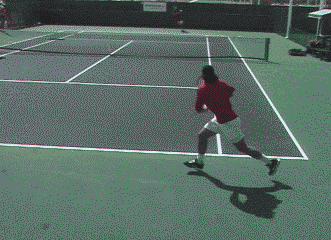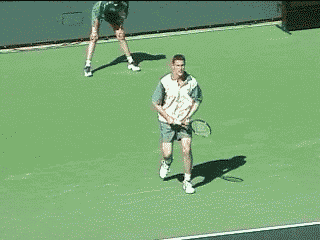|
TennisOne Lessons Rafael Nadal – Movement to the Max by Jim McLennan I have just returned from the Pacific Life Open, where I had the excellent opportunity to watch a lot of tennis, both in the stadium and of equal interest to me, on the practice courts. The pros, both men and women, display wonderful athleticism. As is obvious to anyone who watches the professional game, the combination of power and foot speed about the court is just amazing. But to my eye, there are a number of standout players amongst the field, whose palette of skills separates them from the pack. And on this score I can only marvel at the entire package that Rafael Nadal (Rafa) brings to the court, and apparently he does this each and every day.
It has been said that most players are already mentally defeated when walking on the court with Roger Federer. But now and then we begin to see the occasional crack in Roger’s otherwise impervious armor. A recent loss to Tommy Haas, extremely close matches in the 2006 Australian Open, and now another loss to Nadal in Dubai suggest the guys may start to think they have just the slightest chance against him. Well I believe that Nadal has crafted just such a mental advantage over all the others, who now are mentally defeated when walking onto the court with him. He is dangerous on offense and on defense. He captures the crowd with his fist pumping antics. His intensity and will to win may actually exceed what we saw years ago with Jimmy Connors and then John McEnroe. His professional record certainly speaks for itself. He turned pro in 2001, and has amassed 13 singles title, including the 2005 French Open. His overall singles record is an amazing 131wins against only 40 losses, with $4,808,579 in prize money earned so far. Presently ranked number two in the world, he has a winning record against Roger Federer. They have played four times, with Nadal prevailing in Dubai 2006, at Roland Garros 2005, and Miami 2004. Federer beat Nadal in five close sets in Miami in 2005. This can be said again, this teenage sensation (he turns 20 in June) holds a winning record against a man who some consider the best of all time. Finally, he sets himself apart from all the others on the practice courts as well. I was amazed to see him chase down balls that his hitting partners sprayed wide or long – he truly moved to and returned anything remotely in his vicinity. And he was cracking the ball from the first hit. Nothing about warming up easily, his practices were full speed and full intensity from start to finish. And for you and I, this practice model has such value. Too often we assume the ball might be going out and therefore don’t really run, or when the ball is slightly out we simply let it go, waiting presumably for something easier to return. As a coach told me years ago, “There is no such thing as OUT, in practice.”
Let’s take a look at his footwork. Though he is not necessarily as quick as perhaps Hewitt or Grosjean, where quickness is used to describe speed afoot, Nadal’s movement is dangerous. He gets to nearly as many balls as the others, but he does so much more with the ball when he is stretched wide and out of position. In fact the opening point of his semifinal victory over Federer in the French Open foretold just that. Federer served wide to the deuce court, extremely wide, then he cracked the next ball to the opposite corner, a winner against most, or at minimum sure to create a feeble reply. Nadal raced across the baseline, impossibly out of position, to crush a forehand winner down the line with pinpoint accuracy. This is what bothers Roger and all the rest. Further, his recovery footwork is absolutely remarkable. There is never a moment when the opponent can be sure the point is won, never a moment when Nadal won’t scramble back into position to retrieve yet another ball, never a moment when Nadal won’t engage the crowd and dispirit the opponent with an improbable winner from an otherwise hopeless situation. Against Marcos Baghdatis in the quarterfinals of the Pacific Life Open, Nadal turned the match on its head with just such a point. Marcos served wide to the deuce court, moved to the net and angled an elegant low crosscourt volley into the open court. Nadal got there, whipped an acutely angled cross court pass, and recovered the instant he made contact. He had actually scrambled back into position just as his pass eluded Baghdatis’ outstretched racquet. This is more dynamic recovery footwork than the game has ever seen.
In the following example from the practice courts, Rafa brings it – corner to corner, powerful running strides, dangerous on defense, then turning the tables to finish with offenses. This typifies his game and his commitment. But whereas the retrieving style of Michael Chang (and now Lleyton Hewitt) may shorten ones professional career, taking too much of a toll on the athlete's legs and mind, Nadal moves easily, gliding more than scampering. And I believe the key to this easy running style is something called dynamic imbalance. Getting started when moving to the ball, or changing direction to recover when way out of position, the secret is in the first step. Watch closely as Nadal moves to the second shot of the point, which will be a very wide and difficult ball to his backhand side. He reads the ball as he prepares to land his split step, but places only his left foot on the ground. This one legged landing immediately thrusts him to the right. Then to magnify this effect, he clearly turns his hips and pulls his right leg beneath him, away from the ball, which increases his momentum toward the ball. Not balance, but rather dynamic imbalance, which he controls to enable him to move easily. Then as the rally continues, note that he uses this same technique on his recovery from the forehand corner. He stops and finishes the shot on his left foot, then turns his hips as he drops the right foot beneath him to get a running start back to center. This move has been called a gravity turn (by Don Kerr), a floating pivot (John Gruberg), a drop step, negative step, or even paradoxical step (ITF). And interestingly (at least to me) there has been a tremendous amount of material in support of the opposite, or jab step, when moving to the ball. In this scenario, one steps out toward the ball with the foot closest to the ball. And though many coaches have trained this move, it does appear that the quickest players do not rely on the jab step, but employ the gravity turn when needing to move quickly and to cover a lot of court. But over the years it seems as though the players discover efficient ways of doing things (witness the evolution of the open stance forehand in spite of years of closed stance teaching) and sooner or later the coaches observe these things and gradually change their methods. And what held for the open stance forehand will now follow suit with the gravity turn. And skeptics please know, this technique, though somehow counter intuitive, works as well for you and me as it does for Rafael (and Edberg and McEnroe before him). So how does this counter intuitive if not paradoxical technique feel? I have seen some players who use this footwork without knowing it. That is, they discovered it without being taught. Often they come from a soccer background (where change of direction and agility are at a premium) and in other instances they simply move rather well without apparent effort. The opposite, where people move poorly and with effort, is often the more common scenario.
In my opinion the difference between these two groups is simply the first step – whether they step out to the ball with their lead foot or whether they step away from the ball with their lead foot. But the trick, if not the feeling, is the interplay of balance and imbalance. Stepping out toward the ball with the lead foot actually improves one’s balance by widening the stance or base of support. Certainly one is moving in this manner, but generally with effort and muscle. The opposite, where the lead foot steps away from the ball can cause an immediate loss of balance toward the ball, and when performed with skill this “excursion of mass” will actually reduce effort and increase quickness. But, if you experiment with this, it will be as nuanced as the feel and technique of a backspin drop shot or a topspin lob – that is you must practice, rehearse and experiment until you finally get the feel. The simplest way to experience the gravity turn is to position oneself exactly on the baseline, with the baseline center mark exactly beneath you. Take as wide a stance as is comfortable, at least, if not more than, shoulder width. Then, moving to your right, initiate with a hip turn toward the right, but simultaneous with the hip turn allow your right foot to move beneath you. If done correctly your right foot will turn to the right and will step on the center mark, parallel with the baseline. Normal walking or running strides ensue, but the intent is to capture a quicker start. With repeated practice this move will eventually work its way into your game, initially as you move to the ball, and then on running recovery steps (like Nadal) some day. Persist. It is well worth the effort. Your comments are welcome. Let us know what you think about Jim McLennan's article by emailing us here at TennisOne.
|
|||||||||||




